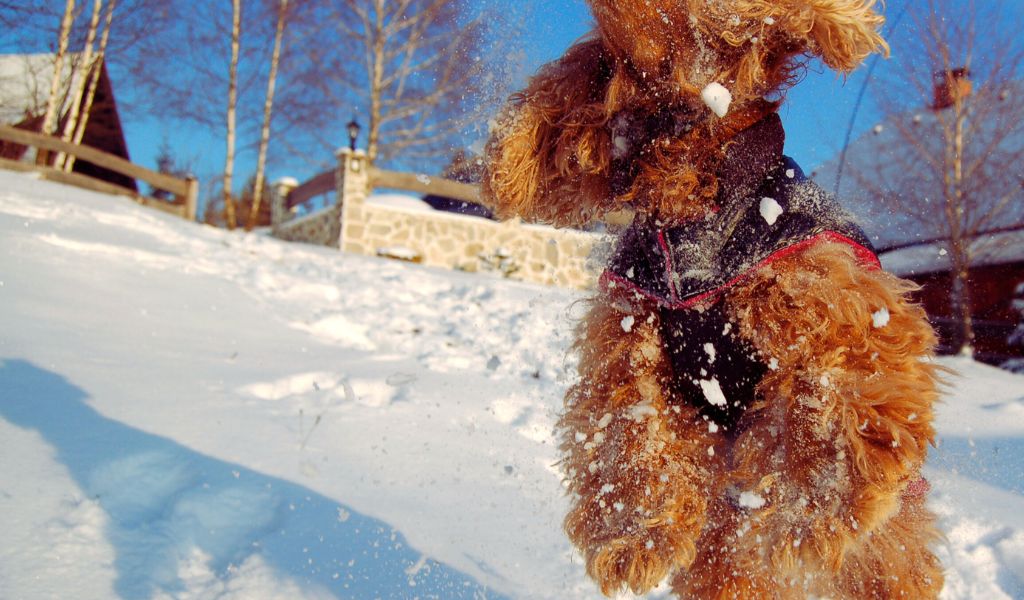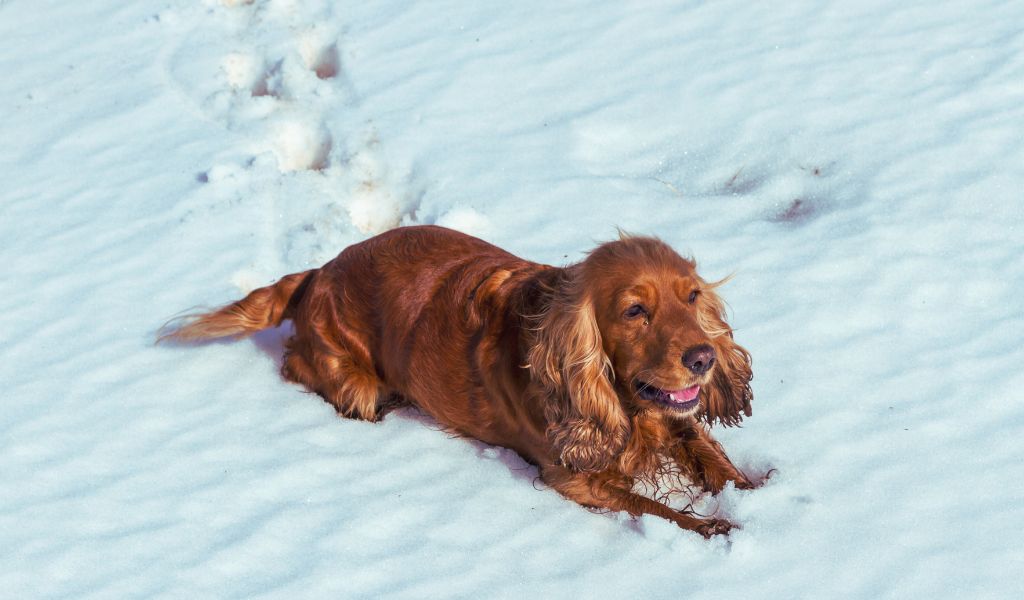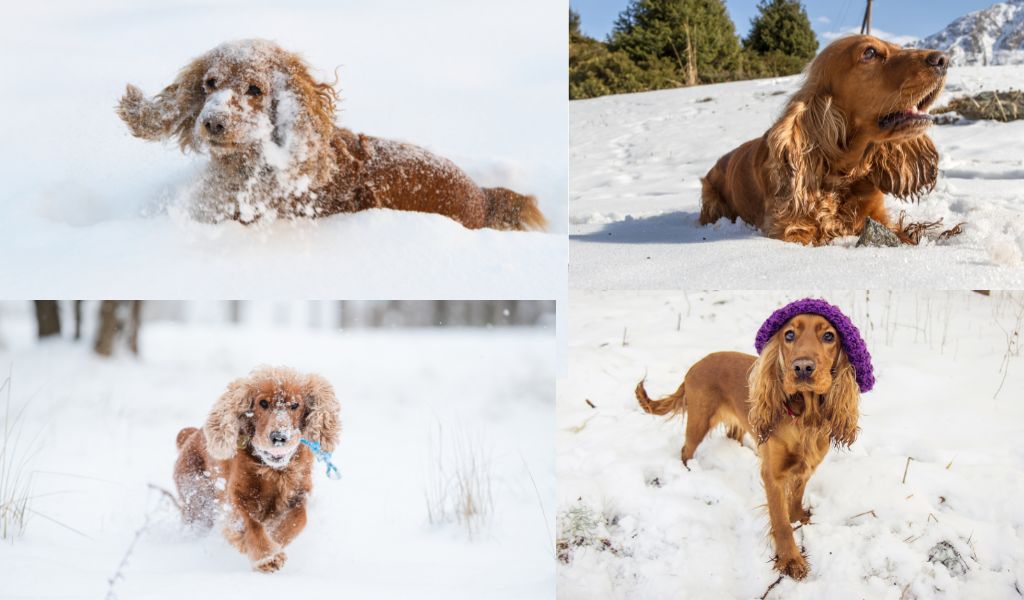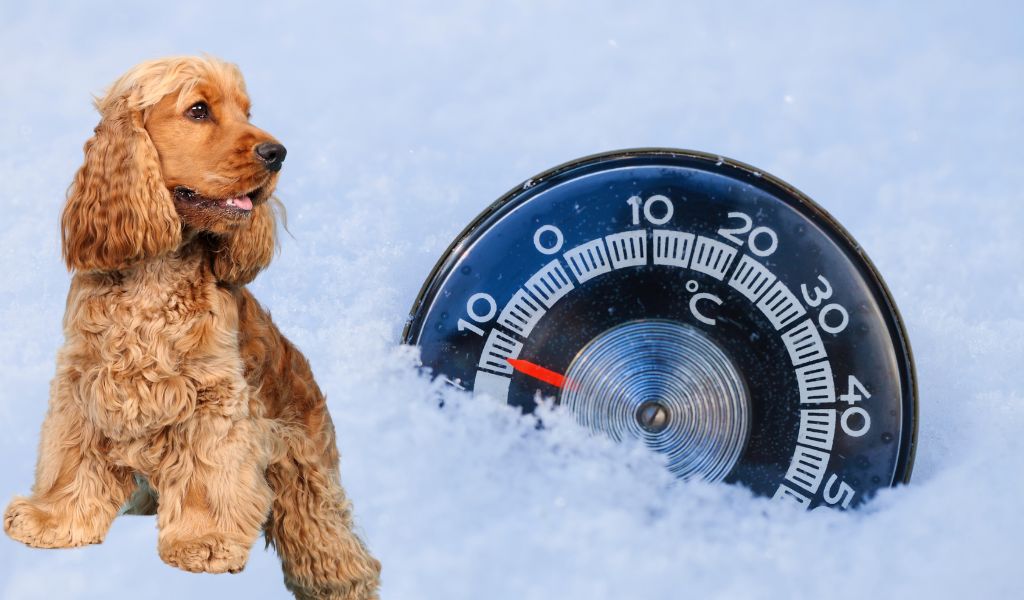Cocker spaniels can tolerate moderately cold temperatures due to their double coat that consists of a dense, insulating layer and a longer, water resistant top coat. Not all Cocker spaniels have the same level of cold tolerance however. Factors such as age, overall health, and individual variations can affect their ability to handle the cold weather.
Understanding the Cocker spaniel’s coat
The Cocker spaniel’s coat plays a vital role in protecting them from the elements.
The thick undercoat serves as a barrier against the cold, while the topcoat repels moisture.
These characteristics make Cocker spaniels more equipped to handle cold weather compared to breeds with shorter or thinner coats.
Signs of cold stress in Cocker spaniels
While Cocker spaniels can handle cold weather to some extent, it’s essential to recognize the signs of cold stress.
Some common indicators that your dog may be feeling chilly include:
Shivering: Shivering is a natural response to cold temperatures and helps generate body heat.
However, excessive shivering or trembling could indicate that your Cocker spaniel is too cold.
Seeking Warmth: If your Cocker spaniel seeks out warm areas or tries to burrow under blankets more than usual, it could be a sign that they are feeling cold.
Lethargy: Cold weather can make dogs sluggish. If your Cocker spaniel appears unusually lethargic or shows a lack of energy during cold spells, it may be a sign that they are struggling to cope with the low temperatures.
Pale or Blueish Gums: Extremely cold weather can affect blood circulation, leading to pale or blueish gums in dogs. If you notice any unusual colouration in your Cocker spaniel’s gums, consult a veterinarian.

Tips for keeping Cocker spaniels warm
To ensure your Cocker spaniel stays warm and comfortable during cold weather, consider the following tips:
Provide adequate shelter
Having a warm and dry shelter is crucial for Cocker spaniels during winter.
Make sure your pet has access to a cozy doghouse or a sheltered area protected from wind and moisture. Insulate the shelter with blankets or straw for added warmth.
Dress appropriately
While Cocker spaniels have a natural coat, some individuals may benefit from extra protection.
Consider using doggy sweaters or coats designed for cold weather. These garments can help retain body heat and keep your furry friend comfortable when venturing outside.

Limit outdoor time
In extremely cold weather, it’s best to limit your Cocker spaniel’s time outdoors. Shorten walks and opt for indoor play or mental stimulation activities instead.
Remember, even with a thick coat, your pet can still be affected by frostbite or hypothermia if exposed to freezing temperatures for prolonged periods.
Protect the paws
Cocker spaniels’ paws are sensitive to cold surfaces and harsh chemicals like salt used to melt ice.
Consider using paw balm or dog booties to protect their paws during walks. Additionally, wipe their paws with a warm, damp cloth after being outside to remove any potential irritants.
Ensure proper nutrition
A well-balanced diet is crucial for maintaining a healthy coat and overall well-being.
During winter, consider adding a bit of extra fat and protein to your Cocker spaniel’s diet to provide them with the necessary energy to keep warm.
Regular grooming
Proper grooming is essential for Cocker spaniels’ coat health. Regular brushing helps remove dead hair, allowing air to circulate and better insulate their bodies.
Additionally, grooming helps prevent matting and skin issues that can be exacerbated by cold weather.

Do Cocker spaniels like the cold?
Cocker spaniels are generally weather-resistant and do not easily get cold, especially if they are healthy adults.
Their ability to tolerate cold weather depends heavily on individual factors like age and overall health.
For instance, Cocker spaniel puppies, elderly dogs, or those with health issues are more sensitive to cold temperatures.
In such cases, it’s advisable for these dogs to stay indoors when temperatures drop below 10°C (50°F).
Moreover, most Cocker spaniels can handle cold temperatures without issues until it falls below 45°F (7°C).
However, certain physical characteristics of Cocker spaniels, like their long ears and wavy leg fur, can collect snow close to their skin, making it harder for them to retain heat.
Thus, owners need to be observant for signs of cold discomfort, such as shivering, reluctance to go outside, or curling up tightly, which are indications that the dog is trying to conserve heat
Are Cocker spaniels more susceptible to cold-related health issues?
Cocker spaniels are generally hardy dogs, but like any breed, they can be susceptible to cold-related health issues such as hypothermia and frostbite if exposed to extreme temperatures for extended periods. Monitoring their well-being and taking necessary precautions is important.
Can Cocker spaniels live outside in cold climates?
While Cocker spaniels can handle cold weather better than some other breeds, it’s generally not recommended to keep them outside in extremely cold climates. They thrive best when living indoors with their human families, enjoying their company and warmth.
Do Cocker spaniel puppies handle cold weather differently than adults?
Yes, Cocker spaniel puppies have less developed coats and may have a harder time regulating their body temperature compared to adult dogs. It’s crucial to provide them with extra warmth and limit their exposure to cold weather until they grow older.
Should I bathe my Cocker spaniel during winter?
It’s generally best to avoid frequent bathing during winter, as wet fur takes longer to dry and can make your Cocker spaniel feel colder. If necessary, opt for dry shampoo or spot cleaning instead.
Can I use a space heater or heating pad for my Cocker spaniel?
While providing additional warmth is important, it’s crucial to use caution when using space heaters or heating pads. Always ensure they are pet-safe and never leave your Cocker spaniel unattended with heating devices to avoid any accidents.
How can I tell if my Cocker spaniel is too cold or too warm?
Pay attention to your Cocker spaniel’s behaviour and body language. If they are seeking warmth or shivering excessively, they may be too cold. Conversely, if they are panting heavily or showing signs of discomfort in warm indoor areas, they may be too warm. Adjust their environment accordingly.
Cocker spaniels can handle cold weather reasonably well, thanks to their double coat and natural insulation.
However, it’s important to monitor their comfort levels and take necessary precautions during chilly winter months.
Providing adequate shelter, dressing appropriately, limiting outdoor time, and taking care of their paws are essential for keeping Cocker spaniels safe and comfortable in cold weather.
By following these tips, you can ensure that your furry companion thrives even when the temperature drops.




